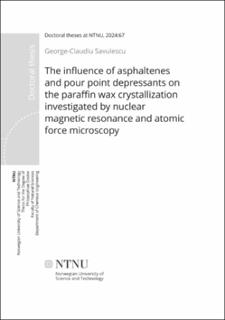| dc.contributor.advisor | Øye, Gisle | |
| dc.contributor.advisor | Simon, Sébastien | |
| dc.contributor.advisor | Sørland, Geir | |
| dc.contributor.author | Savulescu, George-Claudiu | |
| dc.date.accessioned | 2024-03-05T09:37:00Z | |
| dc.date.available | 2024-03-05T09:37:00Z | |
| dc.date.issued | 2024 | |
| dc.identifier.issn | 2703-8084 | |
| dc.identifier.uri | https://hdl.handle.net/11250/3121042 | |
| dc.description.abstract | Wax crystallization in pipelines in cold environments is a key challenge for flow assurance during oil production. Pour point depressants have been used to delay wax crystallization and gelling, by modifying rheological properties of the bulk fluid during wax crystallization. Asphaltenes, the most polar oil components have also been estimated to interact with wax during crystallization. Despite significant advances, the mechanism of interactions between wax and PPD or asphaltenes at molecular scale during crystallization is not yet fully understood and is often based on assumptions, which are not experimentally verified.
This thesis aims to (a) introduce novel quantitative methods for the characterization of wax-inhibitor interactions during crystallization (b) use the developed method to achieve a better understanding of the wax-inhibitor interaction mechanism during crystallization. Novel low field nuclear magnetic resonance (NMR) techniques were developed to relatively quantify the mobility of wax, inhibitor and solvent molecules in model systems. NMR results showed that an amount of dissolved wax lost mobility during cooling in a wax-only system. The formation of a wax crystal network with large pores led to a decrease in the mobility of dissolved species, which became trapped in the resulting matrix. This amount increased once asphaltene concentration reached a critical threshold, corresponding to a shift in the asphaltene aggregation state towards larger nanoaggregates. The precipitation of PPD did not lead to the trapping of dissolved wax, which highlighted an altered crystallization mechanism, based on wax-PPD modified complexes. The molecules in the bulk fluid had a higher level of freedom through the wax crystal network when a higher asphaltene concentration was used and an even higher level of freedom when the PPD was added. Co-crystallization of wax with asphaltene and PPD was quantitatively demonstrated by high resolution NMR methods.
Atomic force microscopy (AFM) was then introduced as a technique to characterize the resulting solid co-crystal networks. The topography and elasticity of crystal network surfaces were investigated. The former led to the quantification of changes in crystal size, shape and in the interlocking patterns of the crystal network. The latter demonstrated that an amorphous, softer layer of wax (50-100 nm), formed on the top of wax and wax-asphaltene crystal networks. The presence of asphaltene nanoaggregates during crystallization generated a loss in stiffness and a swelling of this layer.
Wax crystallization rates were determined by multiple low field NMR techniques, which were applied to both model systems and complex oils. The accuracy of NMR for wax content determination was compared against differential scanning calorimetry (DSC). NMR FID (free induction decay) allowed for a lower cooling rate, using less thermodynamic assumptions and generating a good level of reproduction for samples with high wax content (>10%).
The techniques developed in this thesis could be used on a wider range of systems, to establish a relationship between interactions during crystallization at molecular scale and rheological phenomena observed at industrial scale. This would facilitate the prediction of flow assurance problems that might arise in oils with known chemical composition (wax, asphaltene, added PPD). | en_US |
| dc.language.iso | eng | en_US |
| dc.publisher | NTNU | en_US |
| dc.relation.ispartofseries | Doctoral theses at NTNU, 2024:67 | |
| dc.relation.haspart | Paper 1: Savulescu, George Claudiu; Simon, Sebastien Charles; Sørland, Geir; Øye, Gisle. New Nuclear Magnetic Resonance Approaches on the Evolution of Wax Mobility during Wax Crystallization. Energy & Fuels 2021 ;Volum 36.(1) s. 350-360 https://doi.org/10.1021/acs.energyfuels.1c03613 This publication is licensed under CC-BY 4.0. | en_US |
| dc.relation.haspart | Paper 2: Savulescu, George-Claudiu; Øye, Gisle; Simon, Sebastien Charles Roger; Sørland, Geir. Understanding the Effect of Asphaltenes and Wax Inhibitors on Wax Crystallization by Improved NMR Techniques. Industrial & Engineering Chemistry Research 2023 ;Volum 62.(44) s. 18251-18262 https://doi.org/10.1021/acs.iecr.3c02218 This publication is licensed under CC-BY 4.0. | en_US |
| dc.relation.haspart | Paper 3:
Savulescu, George Claudiu; Rüker,Maja; Simon, Sebastien ; Øye, Gisle.
Alterations in paraffin wax crystal networks induced by asphaltenes and pour point depressants, investigated by atomic force microscopy. | en_US |
| dc.relation.haspart | Paper 4: Savulescu, George Claudiu; Simon, Sebastien Charles; Sørland, Geir Humborstad; Øye, Gisle. Novel Nuclear Magnetic Resonance Techniques To Assess the Wax Precipitation Evolution in Crude Oil Systems. Energy & Fuels 2022 ;Volum 37.(1) s. 291-300 https://doi.org/10.1021/acs.energyfuels.2c03309 This publication is licensed under CC-BY 4.0. | en_US |
| dc.title | The influence of asphaltenes and pour point depressants on the paraffin wax crystallization investigated by nuclear magnetic resonance and atomic force microscopy | en_US |
| dc.type | Doctoral thesis | en_US |
| dc.subject.nsi | VDP::Technology: 500::Chemical engineering: 560 | en_US |

